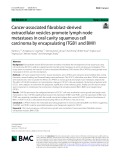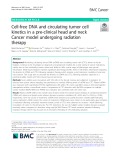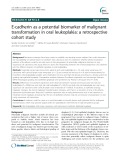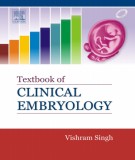
Development of oral cavity
-
Extracellular vesicles (EVs) have been revealed to facilitate the development of oral squamous cavity cell carcinoma (OCSCC), while its supporting role in lymph node metastases is under continuous investigation. This study aimed to examine the function of cancer-associated fibroblasts (CAF)-derived EVs (CAF-EVs) during lymph node metastasis in OCSCC and the mechanisms.
 13p
13p  vikoch
vikoch
 27-06-2024
27-06-2024
 2
2
 1
1
 Download
Download
-
Lung cancer incidence and prevalence is increasing worldwide and there is a focus on prevention, early detection, and development of new treatments which will impact the epidemiological patterns of lung cancer.
 9p
9p  vimahuateng
vimahuateng
 26-11-2021
26-11-2021
 13
13
 0
0
 Download
Download
-
Monitoring circulating tumor DNA (ctDNA) and circulating tumor cells (CTCs), known as liquid biopsies, continue to be developed as diagnostic and prognostic markers for a wide variety of cancer indications, mainly due to their minimally invasive nature and ability to offer a wide range of phenotypic and genetic information.
 11p
11p  vimahuateng
vimahuateng
 26-11-2021
26-11-2021
 7
7
 1
1
 Download
Download
-
Numerous attempts have been made to establish and develop tumor markers that could determine the susceptibility of normal tissues to transform into cancerous ones. To determine whether altered expression patterns of E-cadherin could be an early event in the progression of potentially malignant disorders to oral squamous cell carcinoma, this study aimed to assess the relationship between the immunoexpression of E-cadherin and the different degrees of epithelial dysplasia in oral leukoplakia.
 7p
7p  vialabama2711
vialabama2711
 21-09-2020
21-09-2020
 17
17
 2
2
 Download
Download
-
Disseminated cutaneous histoplasmosis in a 30-Year-Old Male HIV-Positive patient: A rare case report
Histoplasmosis is a systemic mycotic infection caused by Histoplasma capsulatum, a dimorphic fungus. Although histoplasmosis can occur in immunocompetent persons, but immunocompromised individuals, such as people with human immunodeficiency virus (HIV)/acquired immune deficiency syndrome (AIDS), are at high risk of developing disseminated disease. In AIDS patients, mortality may approach 50%, due to disseminated histoplasmosis, especially in those with severe manifestations.
 5p
5p  chauchaungayxua3
chauchaungayxua3
 07-02-2020
07-02-2020
 8
8
 0
0
 Download
Download
-
(bq) part 1 book "ten cate's oral histology - development, structure and function" presents the following contents: structure of the oral tissues, general embryology; embryology of the head, face and oral cavity; cytoskeleton, cell junctions, fibroblasts, and extracellular matrix; development of the tooth and its supporting tissues; bone; enamel - composition, formation, and structure.
 216p
216p  thangnamvoiva5
thangnamvoiva5
 14-07-2016
14-07-2016
 52
52
 3
3
 Download
Download
-
(BQ) Continued part 1, part 2 of the document Textbook of clinical embryology presents the following contents: Digestive tract, major digestive glands and spleen, development of oral cavity, respiratory system, body cavities and diaphragm, development of heart, development of blood vessels, development of urinary system,...
 201p
201p  thangnamvoiva3
thangnamvoiva3
 28-06-2016
28-06-2016
 55
55
 1
1
 Download
Download
-
HACEK organisms are a group of fastidious, slow-growing, gram-negative bacteria whose growth requires an atmosphere of carbon dioxide. Species belonging to this group include several Haemophilus species, Actinobacillus actinomycetemcomitans, Cardiobacterium hominis, Eikenella corrodens, and Kingella kingae. HACEK bacteria normally reside in the oral cavity and have been associated with local infections in the mouth. They are also known to cause severe systemic infections— most often bacterial endocarditis, which can develop on either native or prosthetic valves (Chap. 118).
 7p
7p  ozon_ozon
ozon_ozon
 26-04-2012
26-04-2012
 46
46
 2
2
 Download
Download
-
Harrison's Internal Medicine Chapter 140. Infections Due to the HACEK Group and Miscellaneous Gram-Negative Bacteria The HACEK Group HACEK organisms are a group of fastidious, slow-growing, gram-negative bacteria whose growth requires an atmosphere of carbon dioxide. Species belonging to this group include several Haemophilus species, Actinobacillus actinomycetemcomitans, Cardiobacterium hominis, Eikenella corrodens, and Kingella kingae. HACEK bacteria normally reside in the oral cavity and have been associated with local infections in the mouth.
 5p
5p  colgate_colgate
colgate_colgate
 21-12-2010
21-12-2010
 93
93
 4
4
 Download
Download
CHỦ ĐỀ BẠN MUỐN TÌM





















